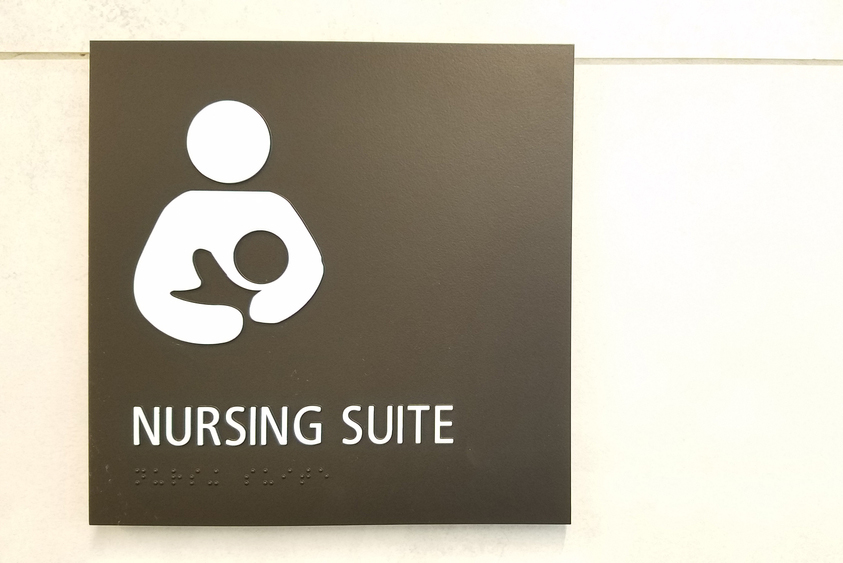As we move toward sharing space at work again, employers often ask us: how can we support our baby-feeding employees? The answer: employers who establish breastfeeding-supportive climates offer comprehensive plans that include policy, procedure, culture of belonging, access to experts, encouragement, community and facilities. In this piece, we’ll examine facilities and identify ways to elevate your family spaces to help remove barriers for working, baby-feeding parents.

Why Workplaces Need Great Lactation Facilities
While the World Health Organization recommends that babies breastfeed until they are 2 years old, most mothers in the United States return to work only 10 weeks after giving birth (and 1 in 4 return a mere 2 weeks after giving birth). Employers are positioned to play a pivotal role in breastfeeding support, including the provision of safe, clean, private spaces for feeding parents to pump (i.e., express milk). For new parents who work, it’s a constant challenge to balance work and breastfeeding demands. When a baby needs to be fed, which happens about every 2 hours, employees must nurse or pump in order to maintain supply, prevent infection, and provide milk for their babies while they are at work.
By investing in great lactation facilities at work, you’re not only creating needed spaces for employees to express milk but also reducing turnover, sick leave, and medical claims for both baby and mom, all while increasing retention and productivity, as well as investing in your employer brand.
At pumpspotting, we got our start helping breastfeeding parents find safe and comfortable places to nurse and pump. As a result, we’ve worked with designers and architects, industry leaders, and real parents to understand what’s most needed and appreciated in a lactation space. To help you consider your best options, let’s categorize various amenities Basic, Better, and Best.
Basic
At the very minimum, and as required by law, employers should provide a private, clean space that is not a bathroom for parents who need to pump. This includes a chair, a table to place a pump on, an electrical outlet, and a locking door. Disinfectant wipes should be available, and the space should be in proximity to a sink and refrigerator. In this most basic setup, a space does not need to be a designated lactation room; it could be someone’s office, a clean closet, or an unused conference room. Privacy and cleanliness are the key elements to keep in mind.
Better
To elevate the lactation space at your workplace, consider providing a hospital-grade breast pump so your workers don’t need to lug their cumbersome equipment back and forth. Send a powerful message about your commitment to support pumping parents when you display permanent signage to designate the space for its use, such as Lactation Lounge. Locate your lounge off the beaten path so pumping feels private and is away from nonlactating coworkers.
Level up by providing the needed fixtures and appliances in your lounge. Your employees will appreciate being able to store their milk, sanitize their parts, and wash their hands in the lounge rather than in nearby bathrooms and kitchens. Add shelves or cubbies for employees to store personal effects, a mirror to check presentability, and a message board to share family photos and messages of encouragement. If demand warrants a multiuser space, provide partitions for privacy.
Best in Class
Want to not only empower women at work with family-friendly benefits but also attract them to a workplace that helps them meet the demands of mothering a young one while killing it at work? Build a state-of-the-art facility by adding some of these features to your already solid lactation lounge:
- Upgrade those swivel chairs to massaging chairs.
- Provide large pump station tabletops to accommodate all their items.
- Add USB ports and charge cords to each station for personal devices.
- Upgrade the mini-fridge to full-size so there’s room for not just milk but also pump kits.
- Add secure lockers for long-term storage of pumps and personal items.
- For multiuser suites, add rooms for each pump station.
- Deepen connection by offering pumpspotting so your team has 24/7 access to lactation consultants, community, and encouragement.
- Create an air of relaxation when you upgrade the lighting and provide creature comforts like lotions, snacks, and drinks.
- Save the day by providing a basket of replacement parts for pumps, disposable milk bags, and disposable nursing pads.
Take Your Next Steps
It’s powerful to support your working parents. You can reduce turnover, sick leave, and medical claims for both baby and mom, as well as increase retention and productivity while investing in your employer brand. A total breastfeeding support program is needed to help feeding parents achieve their goals. In addition to safe and comfortable milk-expression facilities, the best accommodation programs also include policy, procedure, a culture of belonging, access to experts, encouragement, and a community of peers.
Review your facilities—and all the aspects of your support program for baby-feeding parents—and identify opportunities to strengthen your offering. With a strong business case for breastfeeding support, as well as the need to establish diverse workplaces where all employees thrive, you have everything to gain.
Leila Zayed heads pumpspotting’s corporate strategy, bringing her expertise in employee engagement, cross-departmental leadership and project implementation to the team. pumpspotting empowers women by enabling nursing, pumping, and breastfeeding parents to achieve their feeding goals. The company’s software and services, deployed by employers, retailers, universities and other companies, elevate basic accommodations to best-in-class experiences that build brand-exclusive communities, extend the experience beyond physical space, and create opportunities while positioning companies as heroes. Moms love pumpspotting because its encouraging community reduces isolation and anxiety while connecting them with peers, experts and places to feed.
